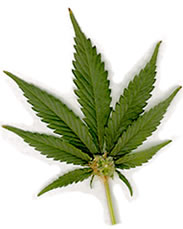Anti Inflammatory Benefits of Marijuana
Cannabidiol, one of the main active ingredients in marijuana is a very effective anti-inflammatory agent. Traditionally, marijuana has been used as poultices applied topically to inflamed areas such as joints and muscles.
The journal of Arthritis Research & Therapy of 2008 reported the characterization of the cannabinoid receptor system in synovial tissue and fluid in patients with osteoarthritis and rheumatoid arthritis. The study reported that marijuana based medicines have a number of therapeutic indications, including anti-inflammatory and analgesic effects. The endocannabinoid receptor system, including the cannabinoid receptor 1 (CB1) and receptor 2 (CB2) and the endocannabinoids, are implicated in a wide range of physiological and pathophysiological processes and demonstrated that cannabis-based drugs have therapeutic potential in inflammatory diseases, including rheumatoid arthritis (RA) and osteoarthritis (OA)
http://www.ncbi.nlm.nih.gov/pubmed/18416822
Anti Nausea and Anti-Vomiting Benefits of Marijuana
The British Journal of Pharmacology of August 2011 reported a study on the regulation of nausea and vomiting by cannabinoids found in marijuana. It is said that considerable evidence demonstrates that manipulation of the endocannabinoid system regulates nausea and vomiting in humans and other animals. The anti-emetic effect of cannabinoids has been shown across a wide variety of animals that are capable of vomiting in response to a toxic challenge. CB(1) agonism suppresses vomiting, which is reversed by CB(1) antagonism, and CB(1) inverse agonism promotes vomiting. Preclinical research indicates that cannabinioids, found in marijuana may offer health benefits for treating both nausea and vomiting produced by chemotherapy or other therapeutic treatments.
http://www.ncbi.nlm.nih.gov/pubmed/21175589
In many clinical studies, the THC-based drug Marinol provides effective anti-nausea benefits than other anti-nausea drugs such as Zofran. Studies suggest that Marinol succeeds in suppressing nausea where other pharmaceuticals failed.
Anti-Glaucoma Benefits of Marijuana
The Journal of Glaucoma. October 2006 published a report on the effects of sublingual application of cannabinoids on intraocular pressure. This pilot study assessed the benefits of delta-9-tetrahydrocannabinol and cannabidiol on the intraocular pressure and its safety and tolerability of oromucosal administration. Results have shown that a single 5 mg sublingual dose of Delta-9-THC reduced the IOP temporarily and was well tolerated by most patients.
http://www.ncbi.nlm.nih.gov/pubmed/16988594
Health Benefits of Marijuana for Patients with Multiple Sclerosis:
The Canadian Medical Association Journal, May 2012 has reported a randomized, placebo controlled study on smoked cannabis for spasticity in multiple sclerosis. Spasticity is a common and poorly controlled symptom of multiple sclerosis. Results have shown that smoked cannabis was superior to placebo in symptom and pain reduction in participants with treatment-resistant spasticity. This suggests that smoking marijuana has potential health benefits in treating and controlling spasticity in multiple sclerosis.
http://www.ncbi.nlm.nih.gov/pubmed/22586334
In a separate study, patients with multiple sclerosis reported that smoking marijuana has soothing benefits to muscle spasms and pain. Other symptoms such as blurred vision, insomnia and depression likewise have been reduced.
Marijuana Health Benefits for Brain and Liver Functions
The British Journal of Pharmacology, April 2011 has reported that cannabidiol improves brain and liver function in a fulminant hepatic failure-induced model of hepatic encephalopathy in mice. Hepatic encephalopathy is a neuropsychiatric disorder of complex pathogenesis caused by acute or chronic liver failure. Results of the study indicated that neurological and cognitive functions were severely impaired in thioacetamide-treated mice and were restored by cannabidiol. Similarly, decreased motor activity in thioacetamide-treated mice was partially restored by cannabidiol. Increased plasma levels of ammonia, bilirubin and liver enzymes, as well as enhanced 5-HT levels in thioacetamide-treated mice were normalized following cannabidiol administration. Likewise, astrogliosis in the brains of thioacetamide-treated mice was moderated after cannabidiol treatment. These suggest that cannabidiol in marijuana restores liver function, normalizes 5-HT levels and improves brain pathology in accordance with normalization of brain function. Therefore, the health benefits of cannabidiol may result from a combination of its actions in the liver and brain. http://www.ncbi.nlm.nih.gov/pubmed/21182490
Marijuana Health Benefits for Chronic Pain:
Marijuana preparations have been used as a pain killer remedy for thousands of years in traditional medicine. The painkilling properties of marijuana (THC) are comparable to those of codeine and other commonly used painkillers without the side effects or risk of addiction. Eating is often more effective than smoking and the effects last longer.
In the Journal of Pain Medicine, November 2009, a systematic review and meta-analysis of cannabis treatment for chronic pain was published. The objective of this review it to assess the efficacy and harms of cannabis preparations in the treatment of chronic pain. Evidence gathered have shown that cannabis treatment is moderately efficacious for treatment of chronic pain, but the benefits may be partially (or completely) offset by potentially serious harms. Further study is required to clarify the balance of its benefits over side effects.
http://www.ncbi.nlm.nih.gov/pubmed/19732371
Marijuana Health Benefits for Diabetes Induced Neuropathy
The Journal of Phytotherapy Research. December 2009, has reported about the beneficial effects of a marijuana extract treatment on diabetes-induced neuropathy and oxidative stress. The study explored the antinociceptive effect of a controlled cannabis extract (eCBD) in attenuating diabetic neuropathic pain. The evidence suggests that repeated treatment with cannabis extract significantly relieved mechanical allodynia and restored the physiological thermal pain perception in streptozotocin (STZ)-induced diabetic rats without affecting hyperglycemia. In addition, the results showed that eCBD increased the reduced glutathione (GSH) content in the liver leading to a restoration of the defence mechanism and significantly decreased the liver lipid peroxidation suggesting that eCBD provides protection against oxidative damage in STZ-induced diabetes that also strongly contributes to the development of neuropathy. Finally, the nerve growth factor content in the sciatic nerve of diabetic rats was restored to normal following the repeated treatment with eCBD, suggesting that the extract was able to prevent the nerve damage caused by the reduced support of this neurotrophin. These findings highlighted the beneficial effects of cannabis extract treatment in attenuating diabetic neuropathic pain, possibly through a strong antioxidant activity and a specific action upon nerve growth factor.
http://www.ncbi.nlm.nih.gov/pubmed/19441010
Marijuana Health Benefits for Alzheimer’s Disease
The British Journal of Pharmacology, November 2007 issue reported a research done suggesting that the active ingredient in marijuana, THC, targeting cannabinoid receptors on microglia may reduce the neuroinflammation that is a feature of Alzheimer's disease, without causing psychoactive effects. The cannabinoids support the brain's intrinsic repair mechanisms by augmenting neurotrophin expression and enhancing neurogenesis.
http://onlinelibrary.wiley.com/doi/10.1038/sj.bjp.0707446/full

 Plant name: cannabis sativa
Plant name: cannabis sativa

